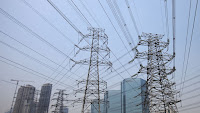Leaders from U.S. and Chinese cities, along with Vice President Joe Biden and a special representative from China, gathered in Los Angeles this week to announce new commitments and targets for meeting carbon emission goals. Unsurprisingly, the event didn’t warrant a mention in Wednesday’s debate, where candidates only denounced diplomacy with China.
The new targets are part of the bigger U.S.-China partnership on climate, which Republican leaders have ridiculed for not requiring action from China. But one announcement made at the U.S.-China Climate-Smart/Low-Carbon Cities Summit points to real, tangible declines in China’s emissions, while offering U.S. scientists an opportunity to study the world’s biggest electrical grid.
The National Renewable Energy Laboratory, a Department of Energy project, will be working with China’s Energy Research Institute, part of State Grid of China, the largest utility in the world and seventh on the Fortune Global 500 list, to study and improve China’s electricity grid.
The partnership grew out of a Chinese initiative, after State Grid’s chairman approached NREL last year to kick off the relationship, John Barnett, manager of NREL’s International Program, told ThinkProgress.
“The head of this enormous utility is thinking beyond the present,” Barnett said. “The air quality issues in China — and many other countries — have gotten more and more attention, and there is pressure on the utility to design a progression to a less polluting grid.”
That means decreasing China’s use of coal, and increasing its use of renewables. “They are planning massive deployments, especially of solar and wind,” Barnett said.
NREL’s agreement with State Grid focuses on three key areas, Barnett said: power system planning and operation support, energy systems integration, and market design. On the U.S. side, the research lab will have access to huge amounts of data as China changes how its electricity is produced, transmitted, and used.
China is the largest global emitter of greenhouse gases, and a large portion comes from burning coal for electricity. For reference, an 8 percent reduction in coal use over the first four months of the year resulted in a nearly 5 percent drop in the country’s overall carbon emissions — equal to the total amount emitted in Great Britain over the same time period.
The sheer scale of the electricity grid in China offers unique opportunities, for deployment of green technologies and for research. One Chinese solar company predicts that China will install 17.8 gigawatts (GW) of solar capacity this year. The United States just passed the 20 GW milestone for all installations.
Read more at This U.S. Lab Just Agreed to Help China Use Even More Renewable Energy

No comments:
Post a Comment